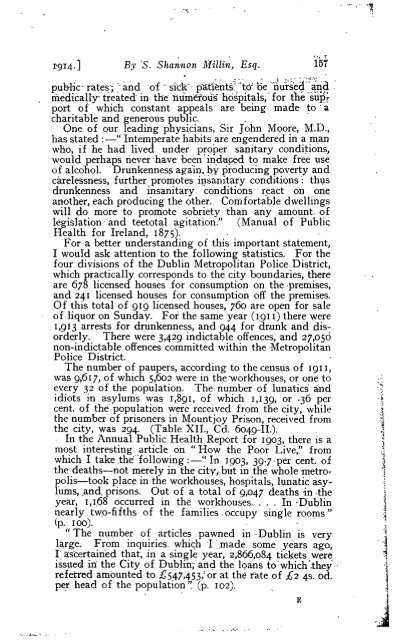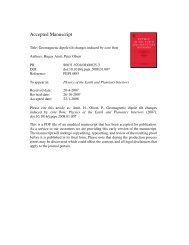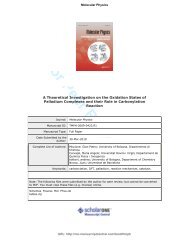Read Friday, 23rd January, 1914. - TARA - Trinity College Dublin
Read Friday, 23rd January, 1914. - TARA - Trinity College Dublin
Read Friday, 23rd January, 1914. - TARA - Trinity College Dublin
You also want an ePaper? Increase the reach of your titles
YUMPU automatically turns print PDFs into web optimized ePapers that Google loves.
P914.] By 5. Shannon Millin, Esq. 157*<br />
public- rates; ' and of " sick" pitientsf'to' be "nursed and<br />
medically-treated in the numerous hospitals, for the sup?<br />
port of which constant appeals are being made to a<br />
charitable and generous public.<br />
One of our leading physicians, Sir John Moore, M.D.,<br />
has stated :—" Intemperate habits are engendered in a man<br />
who, if he had lived under proper sanitary conditions,<br />
would perhaps never have been in duped to make free use<br />
of alcohol. Drunkenness agaip, by producing poverty and<br />
carelessness, further promotes insanitary conditions: thus<br />
drunkenness and insanitary conditions react on one<br />
another, each producing the other. Comfortable dwellings<br />
will do more to promote sobriety than any amount of<br />
legislation and teetotal agitation." (Manual of Public<br />
Health for Ireland, 1875).<br />
For a better understanding of this important statement,<br />
I would ask attention to the following statistics. For the<br />
four divisions of the <strong>Dublin</strong> Metropolitan Police District,<br />
which practically corresponds to the city boundaries, there<br />
are 678 licensed houses for consumption on the premises,<br />
and 241 licensed houses for consumption off the premises.<br />
Of this total of 919 licensed houses, 760 are open for sale<br />
of liquor on Sunday. For the same year (1911) there were<br />
1,913 arrests for drunkenness, and 944 for drunk and .disorderly.<br />
There were 3,429 indictable offences, and 27,056<br />
non-indictable offences committed within the -Metropolitan<br />
Police District.<br />
The number of paupers, according to the census of 1911,<br />
was 9,617, of which 5*602 were in the 'workhouses, or one to<br />
every 32 of the population. The number of lunatics and<br />
idiots in asylums was 1,891, of which 1,139, or -36 per<br />
cent, of the population were received from the city, while<br />
the number of prisoners in Mountjoy Prison, received from<br />
the city, was 294. (Table XII, Cd. 6049-IL). . .<br />
In the Annual Public Health -Report for 1903, there is a<br />
most interesting article on "How the Poor Live," from<br />
which I take the following:—"In 1903, 39.7 per cent, of<br />
the deaths—not merely in the city,-but in the whole metn><br />
polis—took place in the workhouses, hospitals, lunatic asylums,<br />
and. prisons. Out of a total of 9,047 deaths in the<br />
year, 1,168 occurred in the workhouses. ... In -<strong>Dublin</strong><br />
nearly two-fifths of the families occupy single rooms"<br />
(p. 100).<br />
"The number of articles pawned in - <strong>Dublin</strong> is very<br />
large. From inquiries, which I \made some years ago,<br />
I; ascertained that, in a singk year, 2,866,084 tickets were<br />
issued in the City of <strong>Dublin</strong>, and the loans to'whichlthey<br />
referred amounted to ^547,453/ or at the rate of £2 4s. od.<br />
per head of the population" (p. 102).
















